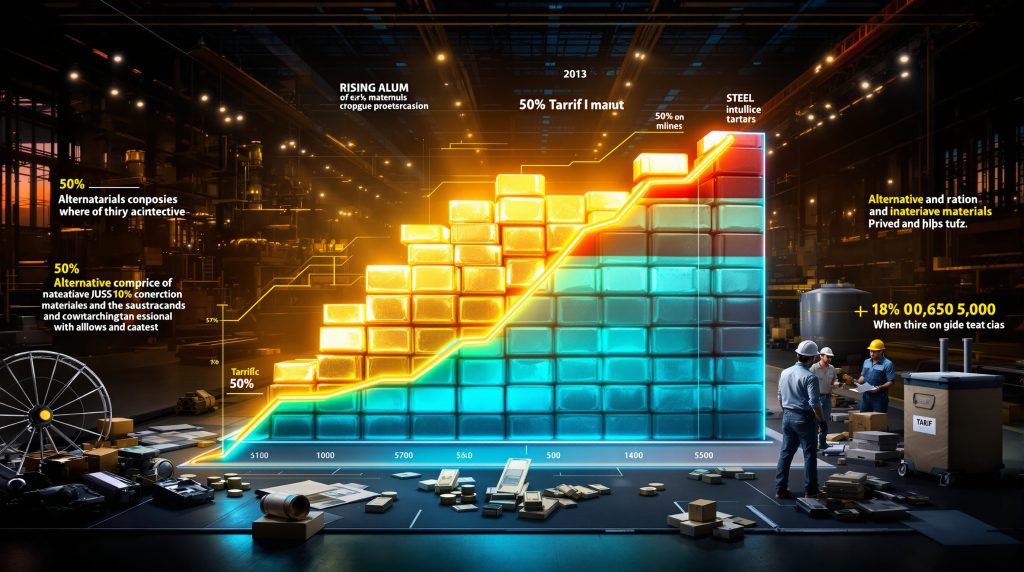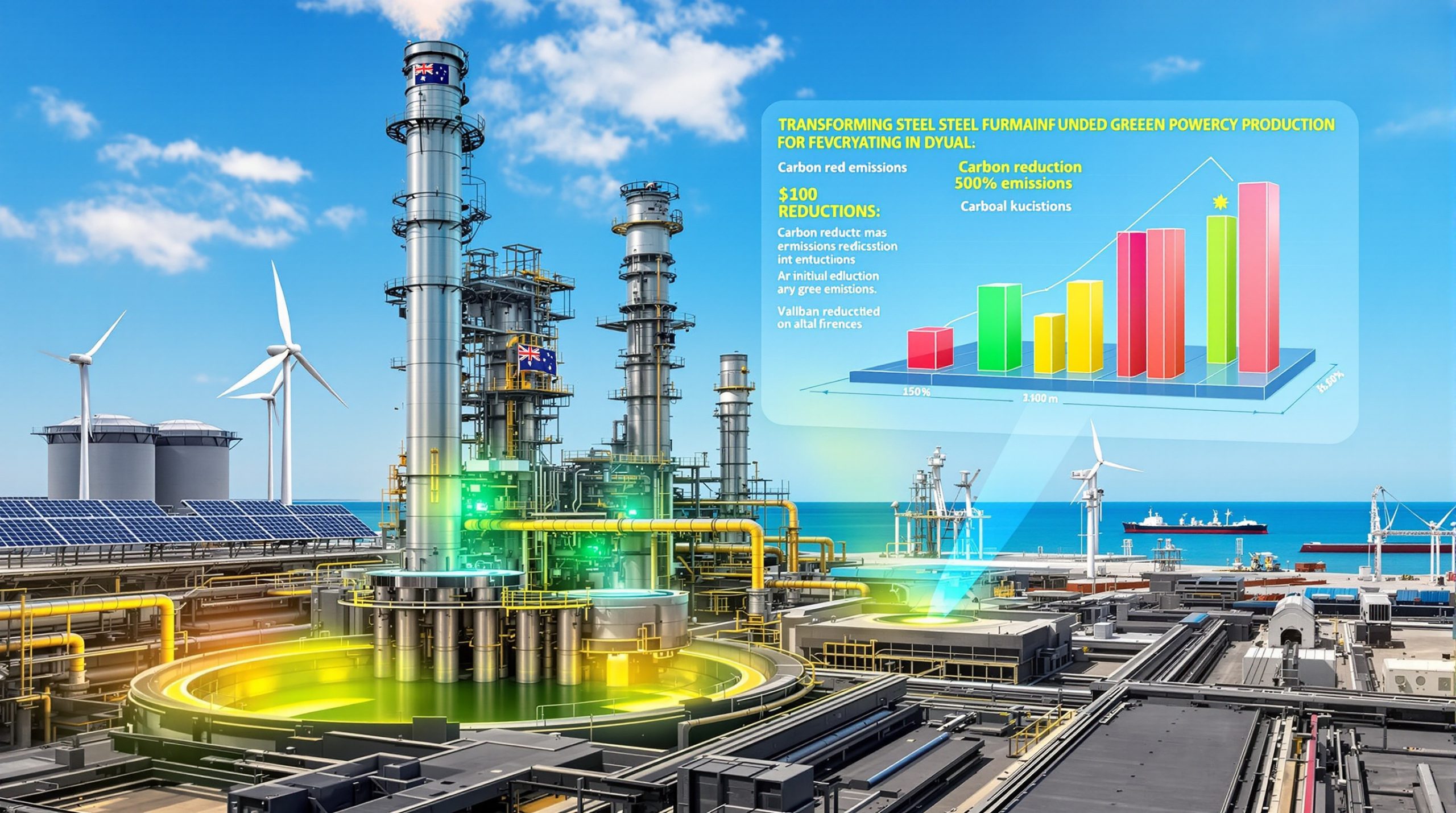How Are Aluminum Tariffs Affecting US Industry?
The implementation of steep aluminum import tariffs has created significant market distortions in the US metal industry. With tariffs now at 50%, domestic aluminum prices have surged dramatically compared to global markets, creating a substantial price gap that threatens long-term competitiveness. This widening differential is placing mounting pressure on manufacturers who rely on aluminum as a key input material across various sectors.
The impact is particularly concerning as manufacturers deplete their pre-tariff inventory stockpiles, forcing them to absorb the 50% premium or pass costs downstream. According to market data from September 2023, aluminum futures were trading at approximately $2,568.50 per ton, with US prices significantly higher than international benchmarks due to the tariff structure.
Current Tariff Structure and Market Impact
- The current 50% tariff rate on imported aluminum represents a doubling from the previous 25% rate implemented in March 2018
- Price premiums in US markets have risen dramatically to cover the tariff costs while maintaining supply chains
- Major domestic producers like Alcoa face an annual tariff burden of approximately $850 million
- Pre-tariff aluminum stockpiles that initially cushioned the market impact have now been largely depleted
- Despite tariffs, metal imports from Canada continue as manufacturers seek supply alternatives
The tariff situation creates a difficult balancing act for the aluminum industry. While domestic producers might temporarily benefit from higher prices, the long-term sustainability of such price differentials remains questionable as market participants adjust their strategies and supply chains.
Economic Consequences for Manufacturers
The artificially elevated aluminum prices are forcing downstream manufacturers to make difficult decisions about material sourcing, product pricing, and long-term production planning. Industries heavily reliant on aluminum—from construction to automotive manufacturing—face compressed margins and reduced competitiveness in global markets.
For construction companies using aluminum in window frames and structural components, the price increases directly impact project costs and feasibility. Similarly, automotive manufacturers incorporating aluminum in vehicle components like the Ford F-150 truck body panels must either absorb higher input costs or pass them along to consumers.
The market distortion also creates competitive disadvantages for US exporters who incorporate aluminum components in their products, as their international competitors operate without comparable input cost burdens. This can lead to reduced export competitiveness and potential loss of market share in global markets.
What Warnings Are Industry Leaders Issuing?
Industry leaders have significantly escalated their warnings about tariff impact analysis since the policies were first implemented. What began as concerns about a potential "quieting effect" on demand has evolved into explicit warnings about permanent demand destruction if the current price differentials persist.
Executive Concerns About Demand Destruction
The head of Alcoa Corporation, the largest US aluminum producer, has warned that the 50% tariffs will ultimately destroy metal demand for American metal—directly contradicting claims that duties would revitalize the domestic industry. CEO Bill Oplinger has been increasingly vocal about these concerns, noting the fundamental economic problem of sustaining artificially elevated prices in a competitive global market.
"It's hard to envision a situation where aluminum is systematically 50% more in the US without some type of demand destruction," Oplinger stated in a recent interview, highlighting the inevitable economic consequences of sustained price differentials. This assessment represents a significant escalation from his January 2023 comments when he described tariffs as having a "quieting effect" on demand.
Key Executive Warnings
- Industry leaders predict inevitable "demand destruction" if the 50% price differentials persist long-term
- Senior executives express concerns that substantially higher US aluminum prices cannot be sustained without significant market consequences
- Warnings emphasize that either consumers or shareholders will ultimately bear the costs of tariff policies
- Major producers have engaged in ongoing advocacy with Washington and global governments about the negative impacts of tariff policies
- Industry analysis indicates growing risk of material substitution as manufacturers seek cost-effective alternatives to aluminum
The shift in messaging from industry leaders reflects mounting evidence that market distortions are becoming unsustainable. While initial price increases could be absorbed through inventory management and temporary adjustments, the long-term structural impact threatens fundamental changes in material selection and product design.
How Do Tariffs Affect Employment in the Aluminum Sector?
The aluminum industry employs thousands of workers across mining, refining, smelting, and manufacturing operations throughout the United States. Despite claims that tariffs would revitalize domestic production and create jobs, industry analysis suggests more complex employment outcomes may occur.
Employment Risk Assessment
- Potential job losses in downstream manufacturing sectors that rely heavily on aluminum inputs
- Limited evidence of significant new hiring in domestic smelting operations despite tariff protection
- Competitive disadvantage for US manufacturers using aluminum components may threaten existing manufacturing jobs
- Market uncertainty prevents long-term workforce planning and capital investment in production facilities
- Regional employment impacts vary based on concentration of primary production versus fabrication operations
While tariffs might temporarily protect some jobs in primary aluminum production, the higher input costs threaten a much larger employment base in aluminum-consuming industries. Construction, automotive manufacturing, aerospace, and packaging sectors all face potential negative employment impacts if material costs remain elevated.
Factors Preventing Domestic Production Expansion
Despite the tariff protection, several factors continue to limit expansion of US aluminum production capacity:
- Substantially higher energy costs compared to international competitors, particularly for energy-intensive smelting operations
- Persistent uncertainty about long-term tariff policy discourages major capital investments
- Aging infrastructure requiring significant modernization capital that may not generate adequate returns
- Global overcapacity continuing to pressure overall market conditions and prices
- Lack of confidence in sustainable returns on investment for facility upgrades or capacity expansion
The combination of these factors explains why domestic production capacity has not significantly expanded despite tariff protection. Energy costs, in particular, represent a structural competitive disadvantage for US smelting operations compared to facilities in regions with lower electricity costs.
What Are the Financial Impacts on Major Aluminum Producers?
The financial performance of major aluminum producers reveals the complex impact of tariff policies. While higher domestic prices might suggest improved profitability, the reality shows more nuanced outcomes for industry participants.
Stock Performance and Financial Metrics
The aluminum sector has faced significant challenges in the stock market, with major producers experiencing substantial valuation declines:
| Company | YTD Stock Performance | Key Financial Impact |
|---|---|---|
| Alcoa | -17% | $850M annual tariff expense |
| Industry Average | -12% | Margin compression |
These financial metrics reflect investor concerns about the long-term sustainability of current market conditions. The substantial tariff expenses directly impact profitability, while the threat of demand destruction creates uncertainty about future revenue prospects.
Order Books vs. Long-term Outlook
While current order books remain strong for domestic producers, industry executives express concern about the long-term sustainability of demand. The current market dynamics show:
- Relatively robust current order volumes despite price increases as customers adjust to new market realities
- Rising premiums implemented to cover tariff costs while maintaining supply relationships
- Growing concerns about future demand erosion as customers explore alternative materials
- Inventory depletion creating temporary market tightness that masks underlying demand trends
- Potential for accelerating demand destruction as alternatives are developed and implemented
The divergence between current order activity and long-term market outlook highlights the transition period the industry is experiencing. As customers work through adjustment strategies, the full impact of price differentials may not be immediately apparent in current market data.
How Are Global Trade Flows Being Redirected?
The implementation of tariffs has significantly altered global aluminum trade patterns. Rather than simply boosting domestic production, tariffs have created complex shifts in how metal flows between countries and regions.
Changing Trade Patterns
- Increased reliance on aluminum imports from Canada despite Canadian trade tensions, as manufacturers seek the closest available supply sources
- Shifts in global supply chains as companies adjust procurement strategies to minimize tariff impacts
- Major producers like Rio Tinto becoming aluminum buyers in the US market due to altered economic incentives
- Redirection of metal flows through countries with preferential trade status where possible
- Strategic inventory management and stockpiling behavior ahead of tariff implementation dates
These trade flow adjustments demonstrate the market's ability to adapt to policy changes, though often with increased costs and reduced efficiency. The persistence of imports despite substantial tariffs highlights the limited domestic capacity to meet market demand at competitive prices.
The redirection of trade flows also creates additional transportation, logistics, and administrative costs that further reduce overall economic efficiency. These hidden costs compound the direct tariff expenses and contribute to the overall burden on the manufacturing sector.
What Are the Broader Economic Implications?
Beyond the direct impact on aluminum producers and consumers, tariff policies create ripple effects throughout the broader economy. These effects extend to construction activity, consumer goods pricing, and overall economic competitiveness.
Construction Cost Inflation
The construction industry, a major consumer of aluminum products, faces significant cost pressures from tariff-induced price increases. Aluminum is essential for numerous building components:
- Window frames and curtain wall systems for commercial buildings
- Roofing materials and drainage systems
- HVAC components and ductwork
- Structural elements in certain applications
- Interior finishes and decorative elements
These rising input costs contribute to overall construction inflation, potentially dampening building activity or requiring design changes to reduce aluminum content. For large commercial projects, the cumulative impact of aluminum price increases can significantly affect overall project budgets.
Automotive Industry Challenges
The automotive sector represents another major aluminum consumer, particularly as vehicle lightweighting initiatives have increased aluminum content in modern vehicles:
- Vehicle frames and body panels, especially in premium and light-duty truck segments
- Engine components and transmission housings
- Wheels and suspension parts that benefit from weight reduction
- Heat exchangers and cooling systems
- Interior structural components
With aluminum prices elevated by tariffs, manufacturers face difficult choices about vehicle pricing, material selection, and production locations. The industry's global nature means that US production faces competitive disadvantages if input costs remain significantly higher than in other manufacturing regions.
How Do Tariffs Compare to Other Aluminum Industry Challenges?
While tariffs dominate current industry discussions, aluminum producers also face other significant challenges that shape their strategic decisions and market prospects.
Environmental and Sustainability Initiatives
Aluminum producers face increasing pressure to reduce environmental impacts and improve sustainability metrics:
- Industry-wide commitments to emissions reduction targets, particularly for energy-intensive smelting operations
- Growing focus on low-carbon aluminum production as customers seek to reduce supply chain carbon footprints
- Customer demand for sustainably produced metals increasing across automotive, packaging, and construction sectors
- Competitive pressure from alternative materials with lower carbon footprints in certain applications
- Regulatory requirements for emissions reporting and reduction adding compliance costs
These sustainability challenges require significant investment and operational changes, creating additional financial pressure beyond tariff considerations. The industry must balance multiple competing priorities while maintaining competitive pricing.
Global Market Competition
Beyond tariffs, the aluminum industry faces several competitive challenges:
- Persistent overcapacity in global production creating downward price pressure in international markets
- Energy cost disparities between regions creating structural advantages for producers in low-cost energy markets
- Technological advancements changing production economics and efficiency requirements
- Shifting demand patterns across different end-use sectors requiring product and marketing adjustments
- Emergence of new producing regions with cost or logistics advantages disrupting established market patterns
The combination of these factors creates a complex competitive landscape where tariffs represent just one of many challenges facing industry participants. Successful companies must navigate this multifaceted environment while maintaining financial sustainability.
What Policy Alternatives Could Address Industry Concerns?
Industry experts have suggested alternative approaches that might better support domestic aluminum production while avoiding the negative consequences of broad tariffs.
Targeted Approaches to Industry Support
Several policy alternatives to tariffs could potentially achieve domestic production objectives with fewer unintended consequences:
- Energy subsidies or incentives for domestic smelters to address one of the key competitive disadvantages
- Investment tax credits for facility modernization to improve efficiency and reduce operating costs
- Research and development support for efficiency improvements and production innovations
- Targeted trade enforcement against documented unfair practices rather than broad tariffs
- Long-term policy certainty to encourage capital investment in domestic capacity
These alternative approaches focus on addressing the underlying competitive challenges facing domestic producers rather than artificially raising market prices through trade barriers. By improving fundamental competitiveness, such policies could achieve more sustainable industry outcomes.
The key advantage of these alternatives is their potential to strengthen domestic production without creating the market distortions and demand destruction risks associated with high tariff rates. However, they would require more nuanced policy development and implementation than broad tariff measures.
FAQs About Aluminum Tariffs and Market Impact
How do aluminum tariffs affect everyday consumers?
Tariff-induced price increases ultimately flow through to consumer products containing aluminum, including vehicles, appliances, electronics, and construction materials. While the impact on any individual product may be modest, the cumulative effect across multiple purchases can be substantial. These higher costs may be passed along as price increases or absorbed as reduced features or quality.
For example, a typical automotive vehicle contains approximately 250-350 pounds of aluminum. At a 50% price premium, this represents a significant input cost increase that must either be absorbed by the manufacturer or passed along to consumers. Similarly, aluminum-intensive products like laptops, bicycles, and kitchen appliances all face increased production costs.
Why haven't tariffs revitalized domestic aluminum production?
Despite tariff protection, domestic producers face other significant challenges including high energy costs, aging facilities requiring substantial investment, and uncertainty about long-term tariff policies. These factors make major capacity expansions financially risky despite the current price advantages.
Aluminum smelting is extremely energy-intensive, with electricity typically representing 30-40% of production costs. US energy prices remain higher than those in competing regions like Canada, Russia, and the Middle East, creating a structural disadvantage that tariff economic implications alone cannot overcome. Without addressing these fundamental competitive factors, tariff protection is unlikely to stimulate significant new production capacity.
How do aluminum tariffs impact international relations?
The implementation of aluminum tariffs has created trade tensions with traditional allies and trading partners, particularly Canada. These tensions can spill over into other areas of international cooperation and potentially trigger retaliatory measures against US exports.
Canada has historically been the largest supplier of aluminum to the US market, with highly integrated supply chains developed over decades. Tariffs disrupt these established relationships and create diplomatic friction that extends beyond the aluminum sector itself. The potential for escalating trade conflicts represents an additional risk factor for overall economic relations.
What alternatives do manufacturers have to paying higher aluminum prices?
Manufacturers facing higher aluminum costs may pursue several strategies:
- Material substitution (using steel, plastics, or composites in place of aluminum)
- Redesigning products to use less aluminum through lightweighting techniques
- Relocating production to countries without tariffs to maintain competitive costs
- Passing costs to customers through price increases
- Absorbing costs and accepting lower profit margins
Each of these strategies carries its own costs and risks. Material substitution may require significant engineering changes and new tooling investments. Relocating production disrupts existing operations and supply chains. Passing costs to customers risks losing market share, while absorbing costs reduces profitability and potentially threatens business sustainability.
How do aluminum tariffs affect sustainability goals?
Higher aluminum prices may inadvertently promote the use of alternative materials with potentially larger environmental footprints. Additionally, by discouraging the use of lightweight aluminum in vehicles, tariffs could indirectly increase fuel consumption and emissions.
Aluminum's recyclability and light weight make it an environmentally attractive material for many applications, particularly in transportation where weight reduction directly translates to fuel savings and emissions reductions. If tariff policies discourage aluminum usage, the unintended consequence may be higher overall environmental impacts across product lifecycles.
Furthermore, if tariff policies redirect production to regions with less stringent environmental controls, they may increase global emissions even if they reduce domestic production emissions. This "carbon leakage" effect represents a counterproductive outcome from both economic and environmental perspectives.
Further Exploration:
Readers interested in learning more about the impact of aluminum tariffs on metal demand can also explore related educational content from Mining.com, which offers industry news and analysis on metals markets and trade policy developments. The complex interplay between trade policy, material costs, and industrial competitiveness continues to evolve, making ongoing education essential for industry participants and observers alike.
Some mining sectors may qualify for proposed tariff breaks which could potentially alleviate some of these pressures in specific segments of the industry. However, the broader Alcoa CEO warns tariffs will destroy metal demand issue remains a significant concern for the overall aluminum market.
Want to Spot the Next Major Mineral Discovery Before the Market?
Stay ahead of the curve with Discovery Alert's proprietary Discovery IQ model, delivering instant notifications of significant ASX mineral discoveries as they happen. Explore how historic discoveries have generated substantial returns by visiting our discoveries page and begin your 30-day free trial today.




